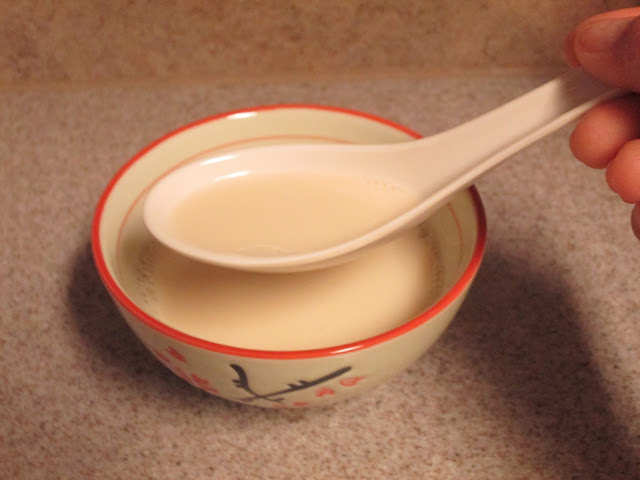I grew up drinking soy milk 豆漿 [Mandarin: dou jiang]. In Taiwan, it was often a part of my breakfast instead of regular milk. In fact, I hated the taste of cow's milk when I was a kid. And while cow's milk eventually grew on me, I still choose soy milk over cow's milk if given a choice.
During my childhood, Taiwanese breakfast stalls sold soy milk in plastic bags. Today, soy milk is more often sold in plastic or paper cups. It can be either sweet, salty, or unflavored. Sweet and unflavored soy milk are consumed more like a drink. Salty soy milk is usually flavored with dried shrimp, daikon, and scallions, and is more savory than salty. Into both types of soy milk, you can dip unflavored fried dough sticks called 油條 [you tiao] (or 油炸粿 in Taiwanese [iu chia kue]).
Youtiao dipped in soy milk
When my family moved to the U.S. about 20 years ago, we would buy soy milk from the Chinese grocery store. It was not yet common in regular grocery stores at that time. In the late 2000's, when soy milk finally could be found in every grocery store, I decided that perhaps it was time to try out the American version of soy milk. I bought a carton of SILK soy milk, poured it into a cup, took a sip -- and promptly spat it out. Missing from it was all the rich taste of the soy bean, and it tasted like artificial flavorings. I don't remember what I did with that carton, but I've avoided buying soy milk from the grocery store from then on.
A few years later, it finally dawned on me that I can make my own soy milk. After some research and experimenting, here is my recipe for authentic Chinese/Taiwanese sweet soy milk.
You will need: 1 cup soy beans (non-GMO, organic), 6-8 cups water plus more for soaking, and sugar (optional).
Place the soy beans into a large bowl. Cover the beans with water and soak overnight. Then drain the water. Here's what the beans look like before and after soaking.
Next, put half of the beans and 3-4 cups of water in a blender.
Blend for about a minute.
Pour the mixture into a large pot. And repeat for the other half.
Blend for about a minute.
Pour the mixture into a large pot. And repeat for the other half.
Heat the soy mixture over medium heat for about 30-45 minutes, stirring constantly. Stirring is essential here: you don't want the mixture to burn or stick to the bottom of the pot. (Note: Sticking is almost inevitable when making soy milk. Stirring just minimizes it.)
Place a strainer over a large bowl and line it with a piece of cheesecloth. (I'm using a nut milk bag here.) Pour the heated mixture through the lined strainer or bag so the soy milk collects in the bowl.
When most of the liquid has drained out and has cooled down enough to handle, squeeze as much of the liquid out of the soy puree into the bowl.
If desired, add sugar to the milk. I opted not to for this batch.
If desired, add sugar to the milk. I opted not to for this batch.
Store the finished soy milk in a sealed glass container in the refrigerator. It should keep up to a week.
This homemade soy milk is rich in taste and nutrients. It can be served hot or cold. And best of all, it does not contain any artificial flavoring or preservative. Enjoy!






























































